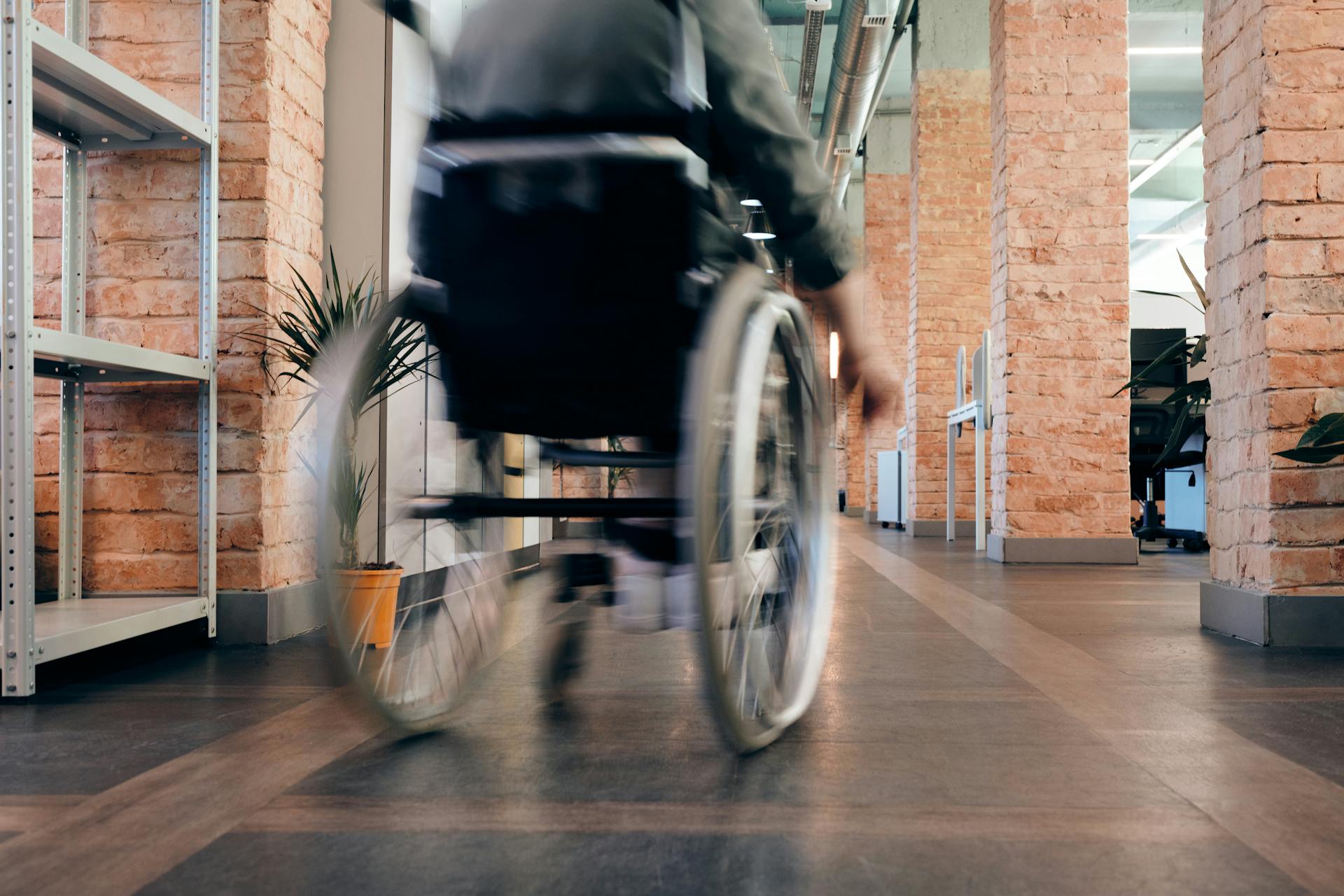
To be eligible for disability insurance DI benefits, you typically need to have a severe injury or illness that prevents you from working. This can be a result of an accident, a chronic condition, or a mental health issue.
The application process for DI benefits can be lengthy and requires extensive documentation. You'll need to provide proof of your medical condition and how it affects your ability to work.
The amount of DI benefits you receive depends on your pre-disability income, which is usually calculated based on your salary or wages. This means that the higher your income, the higher your benefits will be.
If your claim is approved, you can expect to receive a percentage of your pre-disability income, typically ranging from 50% to 90%.
Curious to learn more? Check out: With Disability Income Insurance Benefits Usually Begin
Eligibility and Application
To be eligible for California State Disability Insurance (SDI) benefits, you must have earned at least $300 during the base period, a 12-month period corresponding to one of four quarters.

You must also be unable to do your regular or customary work for at least eight consecutive days. This means that if you're only out for a short period, you might not qualify.
To qualify for SDI, you must be actively seeking treatment from a licensed doctor or accredited religious practitioner during the first eight days of your disability. This is a requirement, so make sure you're seeing a doctor or practitioner as soon as possible.
Once you've met the eligibility requirements, you can file a claim for SDI benefits. There are several types of claims you can make, including Disability Insurance (DI) Claim, Pregnancy Claim, and Paid Family Leave (PFL) Claim.
Here are the different types of claims you can make under the California SDI program:
- Disability Insurance (DI) Claim: Provides short term disability benefits to eligible workers who have lost wages due to a non-work-related illness, injury, or pregnancy.
- Pregnancy Claim: Allows you to claim DI benefits if your pregnancy or childbirth-related conditions prevent you from performing regular or customary work activities.
- Paid Family Leave (PFL) Claim: Provides up to six weeks of benefit payments if you lose wages when you take time off work to care for a seriously ill family member.
- Paid Family Leave Military Assistance Claim: Provides benefit payments to workers who need time off work to participate in a qualifying event because of a family member’s military deployment to a foreign country.
- Part-Time Worker—Disability and Paid Family Leave: Allows part-time workers to claim both DI and PFL under the California State Disability Insurance program.
- Reduced Wages—Disability Insurance and Paid Family Leave: Allows you to file a claim for DI or PFL due to reduced wages if you are working less than full-time due to a disabling condition.
- Self-Employed Disability Leave Insurance Elective Coverage (EC): Provides coverage for DI and PFL benefits for self-employed or independent contractors who have opted to pay into the SDI program.
- SDI and Nonindustrial Disability Insurance (NDI) for State Employees: Provides partial wage replacement to state workers who lose wages due to a non-work-related illness, injury, or pregnancy.
Benefits and Amounts
Disability Insurance (DI) benefits provide short-term disability benefits to eligible workers who have lost wages due to a non-work-related illness, injury, or pregnancy.

The amount of the benefit is determined by your wages during the base period of the claim.
You can claim DI benefits if your pregnancy or childbirth-related conditions prevent you from performing regular or customary work activities.
Certification from a medical provider documenting the condition and its impact on your work capacity may be required.
Part-time workers may be eligible to claim both DI and PFL under the California State Disability Insurance program.
The amount of the benefit for part-time workers is determined by their wages during the base period of the claim.
Here's a breakdown of the types of claims you can make under the California SDI program:
- Disability Insurance (DI) Claim: up to short-term disability benefits
- Paid Family Leave Bonding Claim: up to eight weeks of paid leave
- Paid Family Leave (PFL) Care Claim: up to six weeks of benefit payments
- Paid Family Leave Military Assistance Claim: up to benefit payments
Filing and Claim Process
To file a claim for Disability Insurance (DI) benefits, you can create an account at myEDD (Employee Development Department) for the State of California. You must complete and mail the Claim for Disability Insurance (DI) Benefits (DE 2501) on the day your disability begins, but no later than 49 days after the onset of your disability to avoid losing benefits.

You'll need to provide valid California Driver's License (CDL) or Identification (ID) card number, your full legal name, date of birth, Social Security number, and your most current employer's business information. Additionally, your physician/practitioner will need to complete the medical certification portion of your disability claim.
Here are the required documents and information needed to file a claim:
- Valid California Driver's License (CDL) or Identification (ID) card number
- Your full legal name as it appears on your CDL or ID
- Date of birth as shown on your CDL or ID
- Social Security number
- Most current employer’s business name, phone number, and mailing address (as stated on your W-2 or paystub)
- Last date you worked your normal or usual duties (or the date you began working less than full or modified duty)
Benefit Period
You can expect to receive your first benefit payment within two weeks of filing your claim.
Most people get their payments through a debit card that can be used to buy things or set to automatically deposit your benefit to a bank account.
If you prefer, you can choose to get checks mailed to you.
Your benefit period usually ends on the date your doctor/medical provider listed on your claim form as the date by which you should be able to go back to work.
If you still can't work because of your disability, you and your medical provider can fill out a form asking for a longer benefit period.

SDI is meant to replace income for up to 52 weeks.
If you’re working part-time or have your benefit reduced for another reason, you can receive a benefit for longer than 52 weeks.
Here are the key details about your benefit period:
How to File an SDI Claim
To file an SDI claim in California, you'll need to create an account at myEDD, the Employee Development Department's online portal. You can submit a claim online and provide the required information.
You'll need to complete and mail the Claim for Disability Insurance (DI) Benefits (DE 2501) on the day your disability begins, but no later than 49 days after the onset of your disability to avoid losing benefits. This document is crucial, so make sure to keep track of the deadline.
To access the online claim form, you'll need to provide some personal information, including your valid California Driver's License or Identification card number, your full legal name, date of birth, and Social Security number. You'll also need to provide your most current employer's business name, phone number, and mailing address, as stated on your W-2 or paystub.

You'll also need to provide your last date of work and the date you began working less than full or modified duty. This information will help the California SDI office determine your eligibility for benefits.
Here's a list of the required information to file an SDI claim:
- Valid California Driver's License (CDL) or Identification (ID) card number
- Your full legal name as it appears on your CDL or ID
- Date of birth as shown on your CDL or ID
- Social Security number
- Most current employer’s business name, phone number, and mailing address (as stated on your W-2 or paystub)
- Last date you worked your normal or usual duties (or the date you began working less than full or modified duty)
Remember, you'll also need your physician/practitioner to complete the medical certification portion of your disability claim. This is an important step in the process, so be sure to follow up with your doctor to ensure they complete this part of the application.
Extending My Benefits
If you've received a final payment from California State Disability, you can still request an extension to your benefits if you haven't fully recovered.
Your doctor's expected recovery date is a key factor in determining your eligibility for an extension. If you need more time to recover, your doctor will need to complete a Physician/Practitioner’s Supplementary Certificate (DE 2525XX) to request an extension.
This form will be included with your final payment, and it's essential to have your doctor complete and sign it before submitting it to the program.
The program will review your request and let you know if you're eligible for an extension.
Types of Claims and Situations

You can make several types of claims under the California SDI program, including Disability Insurance (DI) Claim, Pregnancy Claim, Paid Family Leave Bonding Claim, and more. These claims provide benefits for non-work-related illnesses, injuries, or pregnancy, as well as time off work to care for a family member or bond with a new child.
Part-time workers may be eligible to claim both DI and Paid Family Leave under the California State Disability Insurance program, as long as they have paid into the SDI fund via payroll taxes. The amount of the benefit is determined by their wages during the base period of the claim.
Some claims, like Paid Family Leave Military Assistance Claim, provide benefit payments to workers who need time off work to participate in a qualifying event because of a family member's military deployment to a foreign country. Self-employed or independent contractors who have opted to pay into the SDI program can also file an EC claim for coverage under the California SDI program.
Explore further: Condo Insurance Claims

Here are the different types of claims and situations:
Types of Claims Under SDI Program:
Under the California SDI program, you can file a claim for various types of situations. Let's break them down.
You can claim Disability Insurance (DI) benefits if you've lost wages due to a non-work-related illness, injury, or pregnancy. This provides short-term disability benefits to eligible workers.
Pregnancy-related claims are also covered under the program. You can claim DI benefits if your pregnancy or childbirth-related conditions prevent you from performing regular or customary work activities.
Part-time workers may be eligible to claim both DI and Paid Family Leave (PFL) under the California State Disability Insurance program. They need to have paid into the SDI fund via payroll taxes.
Paid Family Leave claims provide up to six weeks of benefit payments if you lose wages when you take time off work to care for a seriously ill family member. This can be a huge help in difficult times.
You might enjoy: Lemonade Insurance Claims

Self-employed or independent contractors who have opted to pay into the SDI program can file a claim for Disability Leave Insurance Elective Coverage (EC). This provides coverage for DI and PFL benefits.
Here are the main types of claims under the SDI program:
- Disability Insurance (DI) Claim
- Pregnancy Claim
- Paid Family Leave (PFL) Care Claim
- Paid Family Leave Military Assistance Claim
- Part-Time Worker—Disability and Paid Family Leave
- Reduced Wages—Disability Insurance and Paid Family Leave
- Self-Employed Disability Leave Insurance Elective Coverage (EC)
- SDI and Nonindustrial Disability Insurance (NDI) for State Employees
Special Situations
If you're blind or have low vision, you're entitled to special rules that take into account the significant impact blindness can have on your ability to work.
The Social Security Administration considers you legally blind if your vision can't be corrected to better than 20/200 in your better eye, or if your visual field is 20 degrees or less, even with a corrective lens.
You may still be eligible for disability benefits even if you don't meet the legal definition of blindness, if your vision problems alone or combined with other health problems prevent you from working.
The monthly earnings limit for people who are blind is generally higher than the limit that applies to non-blind workers with disabilities, in 2025 it's $2,700.
You might enjoy: With Disability Income Insurance an Insurance Company May Limit

Surviving spouses and surviving divorced spouses can't apply online for survivors benefits, they should contact Social Security immediately at 1-800-772-1213 (TTY 1-800-325-0778) to request an appointment.
If you're a wounded warrior or veteran, you may be eligible for benefits, but this is a complex situation and you should contact Social Security to discuss your options.
If you're a child with a disability, you may be eligible for benefits, but you must meet certain requirements, including having a qualifying disability that started before age 22 and meeting the definition of disability for adults.
Here are some special situations and their corresponding requirements:
- Blind or low vision: Vision can't be corrected to better than 20/200 in your better eye, or visual field is 20 degrees or less.
- Surviving spouse or divorced spouse: Contact Social Security at 1-800-772-1213 (TTY 1-800-325-0778) to request an appointment.
- Wounded warrior or veteran: Contact Social Security to discuss your options.
- Child with a disability: Qualifying disability started before age 22, meets definition of disability for adults.
Work and Disability
If you're applying for disability insurance benefits, the Social Security Administration will assess whether your medical impairment prevents you from performing your past work.
They'll consider if you can still do the work you did previously, and if not, they'll look for other types of work you might be able to do despite your medical conditions.
Your age, education, past work experience, and transferable skills will also be taken into account to determine if you can do other work.
What If You Live or Work in a Different State?

If you live or work in another state, the benefits and rules for disability programs can be quite different from what you're used to. Benefits and rules vary greatly from state to state.
You can find a list of state disability programs online to get a better understanding of what's available in your area.
How Work Impacts SSI and SSDI
If you're receiving SSI or SSDI benefits and you're considering going back to work, it's essential to understand how work impacts your benefits. You can start by calling Disability Rights California at 1-800-776-5746, or the Ticket to Work Help Line at 1-866-968-7842, or contacting a Work Incentives Planning and Assistance (WIPA) counselor.
The Social Security Administration will assess whether your medical impairment prevents you from performing your past work. They'll decide if you can do the work you did previously, which is a crucial step in determining your eligibility for benefits. If your medical impairment prevents you from doing your past work, you may still be eligible for benefits.

Here are the steps the Social Security Administration will take to assess your eligibility:
- Call Disability Rights California at 1-800-776-5746
- Call the Ticket to Work Help Line at 1-866-968-7842
- Contact a Work Incentives Planning and Assistance (WIPA) counselor
If you're able to do your past work, you may not be eligible for benefits. However, if your medical impairment prevents you from doing your past work, the Social Security Administration will proceed to the next step to assess your eligibility.
Part-Time Work
If you return to work part-time, you might continue to get SDI benefits. Your SDI benefit amount will stay the same if the total amount of money you get from SDI benefits plus your part-time work is less than what you earned each week just before your disability began.
You can earn some money part-time and still get your full SDI benefit amount. For example, if you earned $1,000 a week before your disability and your SDI benefit amount is $700 a week, going back to work part-time and earning $200 a week won't affect your SDI benefit.
However, if your part-time wages plus SDI benefit are more than what you earned before your disability began, your SDI payment will go down. This is to ensure your total income is not more than your weekly wage.
Can You Do Other Types of Work?

If you can't do the work you did in the past, it's not the end of the road. We look to see if there is other work you could do despite your medical impairment(s).
Your medical conditions, age, education, past work experience, and any transferable skills you may have will be considered. This is to determine if you can do other types of work.
If you have transferable skills, it can be a big plus. For example, if you used to work in a factory but now have a condition that limits your ability to stand for long periods, you might still be able to do office work that requires sitting.
If you can't do other work, you'll be eligible for disability benefits. But if you can do other work, your claim will be denied.
Pregnancy and Disability
Pregnancy can be a time of great joy, but it can also be a time of increased risk for disability, particularly for women with pre-existing medical conditions.

According to the article, pregnancy can exacerbate conditions such as hypertension, diabetes, and heart disease, making it more difficult for women to manage their conditions and increasing the risk of complications.
Women with disabilities may face unique challenges during pregnancy, including difficulties with mobility, communication, and access to healthcare.
For example, a woman with a physical disability may experience difficulty with mobility during pregnancy, making it harder to get around and access medical care.
Women with intellectual or developmental disabilities may face challenges with communication and understanding their medical care, making it essential to have a support system in place.
In fact, research suggests that women with disabilities are more likely to experience pregnancy-related complications and have a higher risk of preterm birth.
The article highlights the importance of accessible healthcare and support systems for women with disabilities during pregnancy, including the need for accommodations such as sign language interpreters and Braille materials.
Long-Term Disability
Long-Term Disability is a type of insurance that provides financial protection for individuals who become unable to work due to a disability.
Private insurance for people who paid premiums or whose employers did is available to continue financial support for years. This type of insurance is designed to provide ongoing financial assistance to individuals who are unable to work due to a disability.
Other Benefits and Reductions
Your disability insurance benefit might be reduced if you receive certain types of income, such as commissions, bonuses, holiday pay, or sick leave pay.
SDI counts these types of income like they were wages, which can affect your benefit amount. For example, if you receive a bonus, it may reduce your benefit.
You're required to report any type of income to SDI, even if it doesn't affect your benefit payments. This includes military pay and other income.
Here are some examples of income that may reduce your SDI benefit:
- Commissions
- Bonuses
- Holiday pay
- Sick Leave pay
- Workers’ Compensation payments
- Military Pay
- Other income
Note that vacation time income is not counted towards your benefit reduction.
Can You Redo Previous Work?

You'll need to assess whether you can redo previous work, which is a crucial step in determining your eligibility for certain benefits. If your medical impairment prevents you from performing any of your past work, you won't qualify for a disability.
If you can't perform your past work, the decision is clear: you don't have a qualifying disability.
Other Benefit Reductions
Your SDI benefit might go down for reasons other than part-time work. Depending on your situation, certain types of income can reduce your benefit.
Commissions and bonuses are counted as wages by SDI, which can lower your benefit. This also applies to holiday pay and sick leave pay. If you're receiving workers' compensation payments or military pay, these can also reduce your benefit.
SDI does not count vacation time income, so you don't have to worry about that affecting your benefit. Any type of income must be reported to SDI, even if it doesn't affect your benefit payments.
Here's a list of income types that can reduce your SDI benefit:
- Commissions
- Bonuses
- Holiday pay
- Sick Leave pay
- Workers’ Compensation payments
- Military Pay
- Other income
If you get a partial benefit, you can receive it until the total amount of your benefit is paid, even if that takes longer than 52 weeks.
Frequently Asked Questions
How long does it take for SDI to pay?
SDI benefits are typically issued within a few weeks after a completed claim is received, with a 7-day waiting period before payments start on the 8th day.
Is disability insurance part of benefits package?
Disability insurance is an optional benefit that can be added to a competitive benefits package. It's available through services like Justworks, which offers a range of employer benefits.
What form does my doctor have to fill out for disability edd?
For Disability Insurance claims, your doctor needs to fill out the DE 2501 form, specifically Part B – Physician/Practitioner's Certificate. This form must be mailed in within 49 days of your disability onset.
Featured Images: pexels.com


